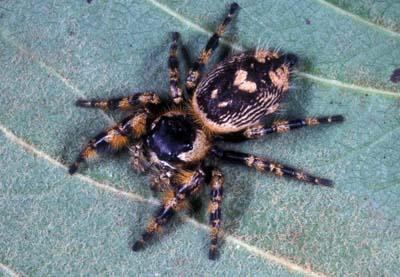
Adult Phidippus otiosus, a jumping spider.
(Photographer: Lyle Buss, University of Florida)
These spiders vary in size, and some species attain a length of up to 18 mm. Males are much smaller than the females. Jumping spiders are readily distinguished from other spiders by their eyes (they have three rows instead of two). Many species are brightly colored, very hairy and robust; the males usually possess iridescent fangs. The body color varies from white to black, and may also be orange, red, or gray. The undersides of most jumping spiders are gray. Spiderlings (immatures) are similar in appearance to adult spiders. Initially, they are dark colored, but acquire their colorful bands later in their development.
After mating, female jumping spiders lay eggs during the spring and summer. The egg sac is somewhat flattened, cream to white in color, and can be found in crevices, under boards, under eaves and in man-made structures.
Jumping spiders do not construct webs and are found in open wooded areas, in fields, and around palms, palmettos and man-made structures throughout the United States.
These spiders feed on beetles, earwigs, flies, aphids, crickets, grasshoppers, mites and other spiders.
Images
To save the Web-optimized images shown below to your hard drive:
|
Click to access Display and Print quality images. |
|
Click to access Display and Print quality images. |
|
Click to access Display and Print quality images. |
|
Click to access Display and Print quality images. |
|
Click to access Display and Print quality images. |